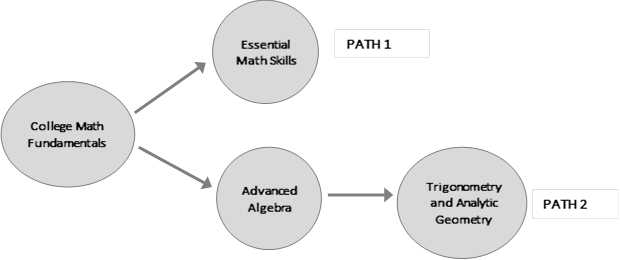Stage Adaptive Testing
Tailwind Mathematics Placement Exam
In a traditional computerized adaptive test, the test adapts after each item (i.e. a student’s response to a particular test question influences the next question that is presented to the student). However, in a stage-adaptive test, the test adapts after a particular section of the test rather than after each item.
The Tailwind Mathematics Placement Exam has a single, fixed point of adaptivity. All students will begin by receiving the College Math Fundamentals (CMF) section of the placement exam. Depending upon performance on CMF, a student will either receive the Essential Math Skills (EMS) section of the test or both the Advanced Algebra and Trigonometry and Analytic Geometry sections of the test. The two pathways of the Math Placement Test are shown below.

The CMF cut score to determine which of the two paths the student will follow has been determined by the Tailwind program through a rigorous standard setting process to identify the performance level corresponding to college-readiness in mathematics, based on national standards. The branching score, therefore, cannot be modified. The assumption is that no student should need to complete all four sections of the mathematics exam in order to be placed appropriately.
Students who score high enough on CMF will have demonstrated adequate knowledge to be placed into a credit-bearing mathematics course and therefore, it is unnecessary for them complete the Essential Math Skills section of the test. Similarly, students who score low on CMF are likely in the position that the content measured on the Advanced Algebra and Trigonometry and Analytic Geometry portions of the test is too advanced. Therefore these students would benefit from receiving the Essential Math Skills section of the test to help determine placement. By utilizing a stage-adaptive format, the Tailwind Mathematics Exam can be efficient while maintaining accurate placement for students at all ability levels.